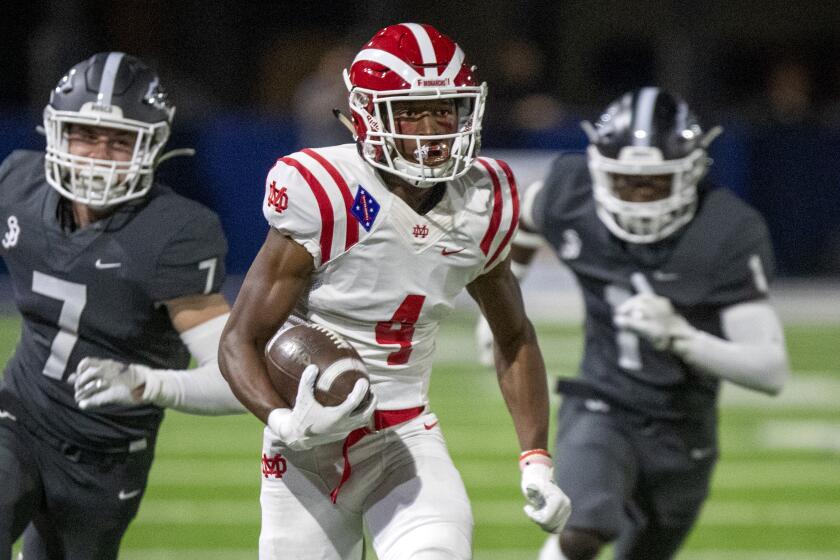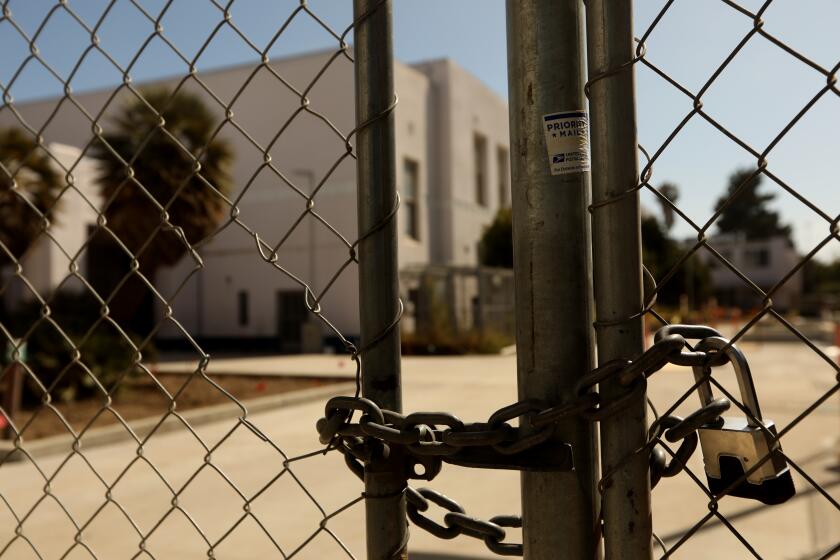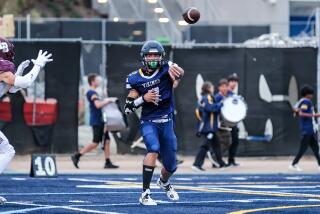Postponing high school football season could create major dilemma for top players
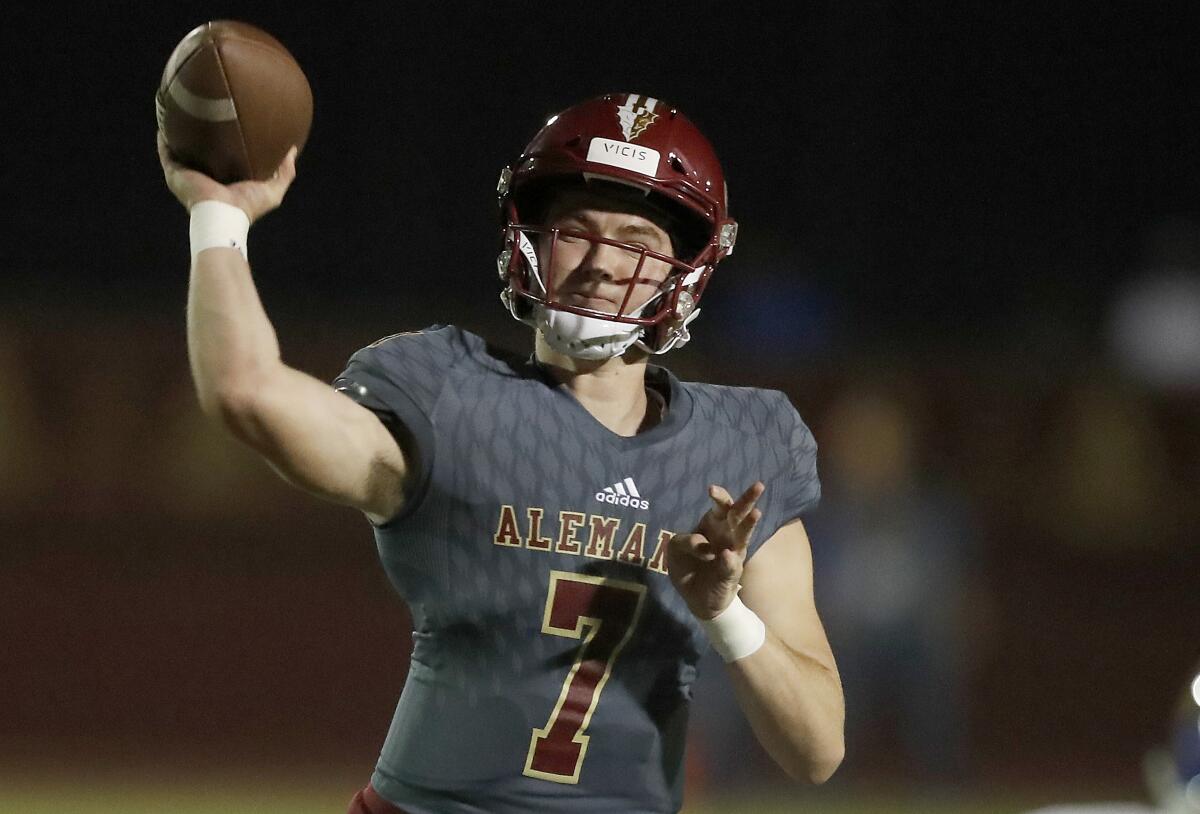
- Share via
When Miller Moss transferred to Santa Ana Mater Dei in June, he knew his time there would be brief. The quarterback’s plan always had been to graduate high school early and hit the ground running with college football, just as soon as the rules allowed.
In that sense, Moss wasn’t unlike other top prospects in Southern California, an increasing number of whom have skipped their final semesters to get to a college campus as soon as possible. The path to that early exit wasn’t easy — it meant taking summer school classes and piling on extra work between practices and training sessions.
But Moss, who played last season at Mission Hills Bishop Alemany, was determined to get a leg up. It was that same instinct that led him to Mater Dei — home to a long lineage of Trojans passers — where he planned to test himself against the best before leaving for USC in January.
But instead of six months at Mater Dei, Moss spent just 10 practices as the Monarchs’ quarterback-in-waiting this summer, testing only invisible defensive backs, before the pandemic threw a wrench into his plans.
Now, with practices postponed and the high school football season up in the air, Moss can’t say for sure that he’ll ever take the field for Mater Dei.
More clarity is expected Monday, when the California Interscholastic Federation is set to make an announcement about the upcoming high school football schedule. But optimism, on all fronts, is waning. Considering the backdrop — with COVID-19 cases spiking statewide — and the timing — just weeks from the season’s start — a significant delay for high school football now appears to be a foregone conclusion.
The California Interscholastic Federation released a high school sports calendar that delays the start of fall sports due to a summer coronavirus surge.
The ramifications of that decision are expected to leave Moss and other early-enrolling top prospects with an unprecedented dilemma, one that could alter the landscape of high school football in the Southland: If the season is postponed until 2021, will they stick around to play their final high school season? Or would they skip it entirely in favor of college football where the immediate future is just as muddled?
Every answer seemingly begets another question, and the lingering uncertainty has frustrated players, parents and coaches alike. Some worry a postponement could spark an exodus of not just early enrollees, but also other top prospects concerned with the quick turnaround to a college football season.
Bruce Rollinson, Mater Dei’s longtime coach, specifically mentioned five-star linebacker Raesjon Davis, who’s committed to Louisiana State, and wideout Kyron Ware-Hudson, who’s committed to Oregon, as examples of top prospects who could reconsider their status for a spring season.
“If our season gets pushed, would they even want to play?” Rollinson asked. “Would they just forgo their senior year, so they’re not taking a chance on getting hurt in February?”
A decision would be more pressing for his new quarterback. Moss would like to play his final high school season. But after years of working toward an early graduation, is he willing to give up the head start he strived for at USC?
Moss isn’t ready to decide just yet.
“Our approach now is just to keep all options on the table,” he said. “I can go into college whenever I feel I need to.”
Depending on the fate of college football, that may not be up to him. If the season were postponed to the spring — an option many coaches and administrators have deemed “a last resort” — it’s unclear if prospective early enrollees would even be allowed to enroll.
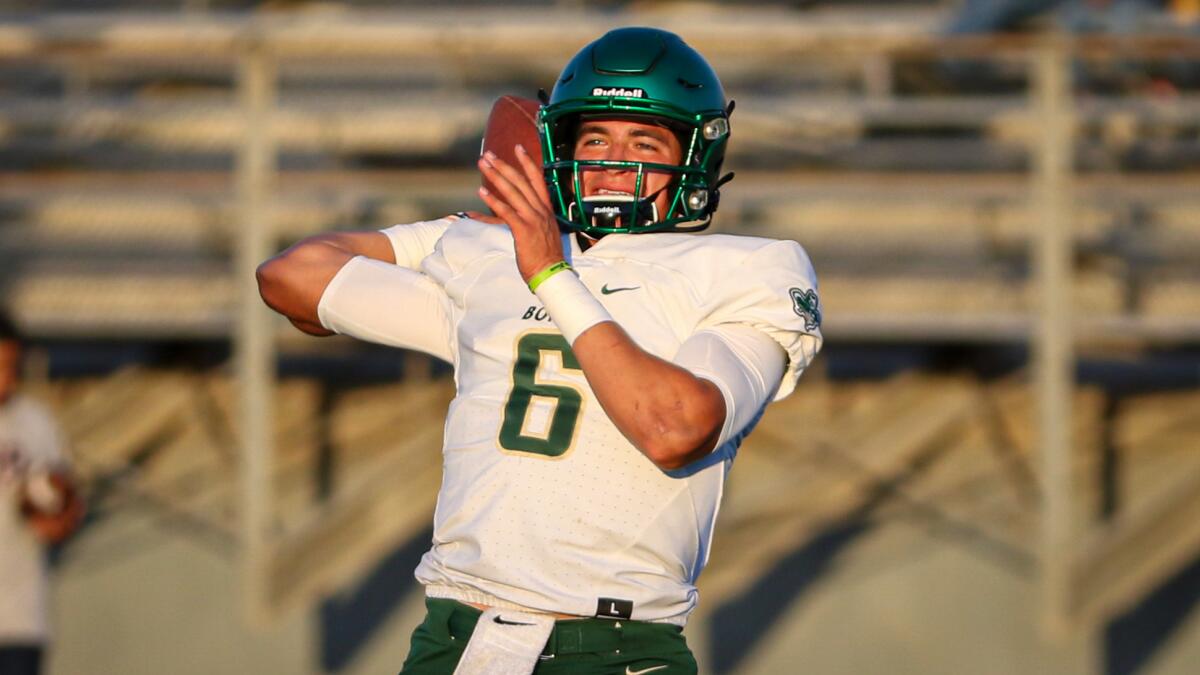
Such a scenario theoretically would require the NCAA to extend its scholarship limits temporarily past 85, while jumping through an array of logistical hoops as it pertains to eligibility. Then, there’s the question of what those early enrollees could do once they enrolled.
Would they be allowed to practice? Would the NCAA even let them play in a spring season?
“Or am I just going to be quarantined alone on campus?” asked Jake Garcia, USC’s other top quarterback commit in the 2021 class.
Garcia, like Moss, was set to helm a new high school program for just a semester. In January, he transferred from Harbor City Narbonne to La Habra, practicing just enough with his new team to get his bearings.
It was enough to get Frank Mazzotta, La Habra’s coach, dreaming of his potential. “He might’ve thrown for a billion yards,” Mazzotta said.
Garcia has yet to even play a full season as a high school quarterback. But if forced to choose between high school and early enrollment at USC, Garcia says his short stint at La Habra isn’t likely to make him reconsider his plans. He’s headed to college, assuming the four-star quarterback still can enroll in January.
“Let’s say I was at the same school for four years, [then] I’d definitely stay,” Garcia said. “I feel like I’ve put in all the work to get ahead. If I’ve put in that work, I feel like I’ll want to leave, just to go and get a head start in college.”
A head start could be especially pertinent for Moss and Garcia, both of whom have plans to position themselves as the Trojans’ quarterback of the future.
Neither has signed a letter of intent to play at USC, and with both high school and college football seasons up in the air, it’s unclear when they’ll actually put pen to paper. The fate of the early signing period is another in a long list of unknowns the NCAA must answer.
Moss committed to the Trojans in June with the knowledge that he’d have to compete with a fellow top-flight freshman passer. Garcia, who committed last September, reiterated his pledge this week, noting that he’s “still all-in” on USC, whether the season is postponed or not.
The CIF is expected to postpone the fall sports season until January 2021, creating a new set of problems for high school athletes this fall and next year.
Danny Hernandez, a private coach who trains both quarterbacks, expects they’ll be watching each other closely.
“I’m sure they’re both going to be looking over their shoulders at one another, like, ‘What decision are you making?’” Hernandez said. “‘Are you going to get there before I do?’ It’s human nature. No one wants to show up late to the party.”
With so many questions still unanswered, several Southland coaches suggested the most prudent path could be to stand pat in high school. Though, there’s no guarantee prep football will safely continue in the spring, either.
“My biggest thing is the uncertainty of NCAA football,” Hernandez said. “I wouldn’t try to jump into that anytime soon. Who’s to say the season doesn’t start, and then they put a hold on it? What happens to their eligibility? I’d try to hold off my collegiate career’s start as much as I can.”
It’s an option that Moss must consider — albeit, through gritted teeth. With cases of the virus still spiking, he wonders what might be different in January, when he was meant to enroll at USC.
“Our country as a whole, we’ve done the worst job imaginable handling this,” Moss said. “Now we’re in a situation where a lot of us won’t be able to play a football season.
“It’s upsetting, without a doubt.”
More to Read
Get our high school sports newsletter
Prep Rally is devoted to the SoCal high school sports experience, bringing you scores, stories and a behind-the-scenes look at what makes prep sports so popular.
You may occasionally receive promotional content from the Los Angeles Times.

